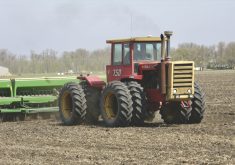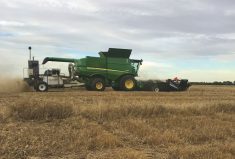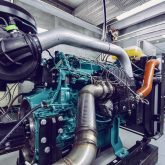The images in early October were stunning. Hurricane Fiona had sent a record-breaking ocean storm surge against Newfoundland coastal communities, leaving death and devastation in its wake. It’s the kind of event climate scientists have warned would occur more frequently due to global warming.
At the same time, across the globe record flooding was wreaking havoc in Pakistan.
This isn’t the first year for an unusually high number of extreme weather events. The spectre of a more dangerous world due to natural disasters hasn’t only caught the attention of the insurance industry. Ag equipment manufacturers have also spent more than a little time pondering how a world with a more uncertain climate would affect their bottom lines.
Read Also

The pros and cons of new technologies
New farm technology hitting the marketplace can be awfully enticing, and it’s not been unheard of in years gone by…
Their farmer-customers are almost certainly among those most vulnerable to extreme weather trends. Farmers who have fields burned brown due to drought won’t have cash to spend on new equipment — or much else, for that matter. Weather disasters for producers translate into lower sales, profits and share prices.
Starting the discussion
At the moment, profits and sales figures still look pretty good across all brands, but CEOs have recognized it’s time to prepare for a future that could hold dramatic changes. Like its two main rivals, AGCO has already started a public discussion about climate change and its preparations for a more uncertain economic picture if the warming of the planet continues. It’s looking not only at the risks, but how the company might find new economic opportunities. Its “TCFD Report” published last year discusses the risks and opportunities in an uncertain future.
“The TCFD framework identifies climate-related risks and opportunities in two major categories: physical and transition,” reads the brand’s explanation. “Physical risks are defined as the direct impacts of shifts in climate change patterns and related events. Transition risks and opportunities, on the other hand, result from society’s response to climate change.”
The report takes a look at two scenarios. One is where the global temperature increase remains below what climatologists say is a critical two degrees, which would be due to widespread mitigation efforts. A second scenario is with no significant effort to address the problem and the temperature rise hits 4.4 degrees.
“After all risks and opportunities were ranked on risk exposure,” the authors explain, “we held interviews with internal subject matter experts from the TCFD Working Group to determine how well-prepared we are to mitigate the identified risks, to determine where there are gaps to close, and to discover ways to capitalize on the identified opportunities.”
Main elements
The main elements considered are broken down into four categories. First is the effects of a government legal and policy framework. That includes increased costs due to carbon pricing, logistics and supply chain pricing, as well as the effects of regulating fertilizer and water use.
Second is the cost of converting to new technologies, opportunities for carbon sequestration and a changeover to renewable energy sources.

Third is the effect of acute events such as supply and infrastructure disruptions such as those due to COVID-19 and war in Eastern Europe. Then it looks at how acute weather events like drought and fires could have on crop yields.
[RELATED] Watching a new world order unfold
Fourth is the continued impact on yields from a warmer environment where plants are subjected to persistent heat stress.
While no company on its own can significantly effect the global climate trend, there is a recognition by AGCO leadership that the firm also has to do its part. It aims to cut GHG emissions from its manufacturing plants by 20 per cent compared to 2020 levels over the next four years. It wants to reach 60 per cent renewable energy use at those same plants by the same date. Finally, it wants its first alternative-fuel tractor, the battery electric Fendt e100, to hit the commercial market by 2025.
Green going green
Over at John Deere, there is also an effort to provide machines with alternative fuel drivelines, just like Fendt’s e100. The green brand has recently acquired majority ownership of a European-based battery producer, Kreisel Electric.“The strategic alignment with Kreisel,” says Deere, “will also serve as the cornerstone for the electrification of John Deere Brand products.”
Since finalizing the deal, Deere announced it will be funnelling a large chunk of cash into increasing production capacity at Kreisel. “The significant capital commitment,” says Deere, “will bring an increase of over 2 GWH to Kreisel battery production capacity, beginning with the opening of a new facility … in the European Union.” Deere will also open a new battery assembly plant in the U.S.
Markus Kreisel, managing director at Kreisel Electric said, “We welcome this strategic investment to help us answer the ever-increasing international demand for Kreisel battery technology. Now is the time for us to start running and demonstrate leadership in the pursuit of electrification.”
CNH Industrial, parent company of Case IH and New Holland, also put out a sustainability report last year. Like its competitors, it believes reducing its overall carbon footprint “is fundamental for the continuous improvement of the company’s performance and the protection of the environment.”
CNH’s 2021 Sustainability Report sets out some ambitious targets to hit by 2024, compared to its 2014 carbon footprint. It also provides an update on the company’s progress toward meeting them. At least one goal, matching Deere’s intention of reducing CO2 emissions from production plants worldwide by 50 per cent, has already been surpassed. CNH has already hit a 55 per cent reduction. And the target of recovering 95 per cent of waste emitted from plants has now been exceeded as well.
[RELATED] Grainews: First methane-fuelled tractor hits the market
CNH also wants to soon have 80 per cent of the electricity used at those facilities come from renewable sources. It is close to its target on this one too, having now climbed to 74.9 per cent.

And like Deere and AGCO it sees a need to offer its customers equipment powered by alternative energy sources. But natural gas powertrains are where CNH sees a future. It claims to already offer 20 per cent of its equipment with that fuel choice, getting close to its target of 25 per cent.
Maintaining investment capital
While all of these efforts contribute to limiting emissons, there is another element to consider. Many investors are beginning to consider the ethical responsibility of companies as a key consideration in where they place their money. Having a strong record of environmental responsibility could become essential in keeping investment funds flowing in and stock prices up — not to mention maintaining consumer approval.
A 2017 study cited by Forbes revealed that 92 per cent of U.S. citizens are more likely to trust a company that demonstrates social and environmental responsibility. So not surprisingly, CNH’s report also addresses that consideration and touts its current standing among ethical investment funds, it reads: “In 2021, the company was included for the 11th consecutive year in the Dow Jones Sustainability Indices (DJSI) World and Europe, achieving the highest score (88/100) out of 126 companies assessed within the machinery and electrical equipment industry. Furthermore, for the first time, CNH Industrial was simultaneously included in the prestigious A List of both the CDP Climate Change and CDP Water Security programs, in recognition of its actions to tackle climate change and to protect water security. It also won the S&P Global Gold Class Sustainability Award 2022, and was awarded ISS ESG Prime status.”
At AGCO, the company’s chairman, president and CEO also took the time to address environmental responsibility in his company’s Sustainability Report, saying: “Decarbonizing our operations and products is going well. We increased the use of renewable electricity across our facilities to 52 per cent and renewable energy to 32 per cent, and achieved an eight per cent reduction in emissions intensity during a record year of growth.”
If — or possibly more accurately as — acute climate events continue to occur, the trend toward increased environmental sensitivity by ag equipment manufacturers is likely to intensify.
















